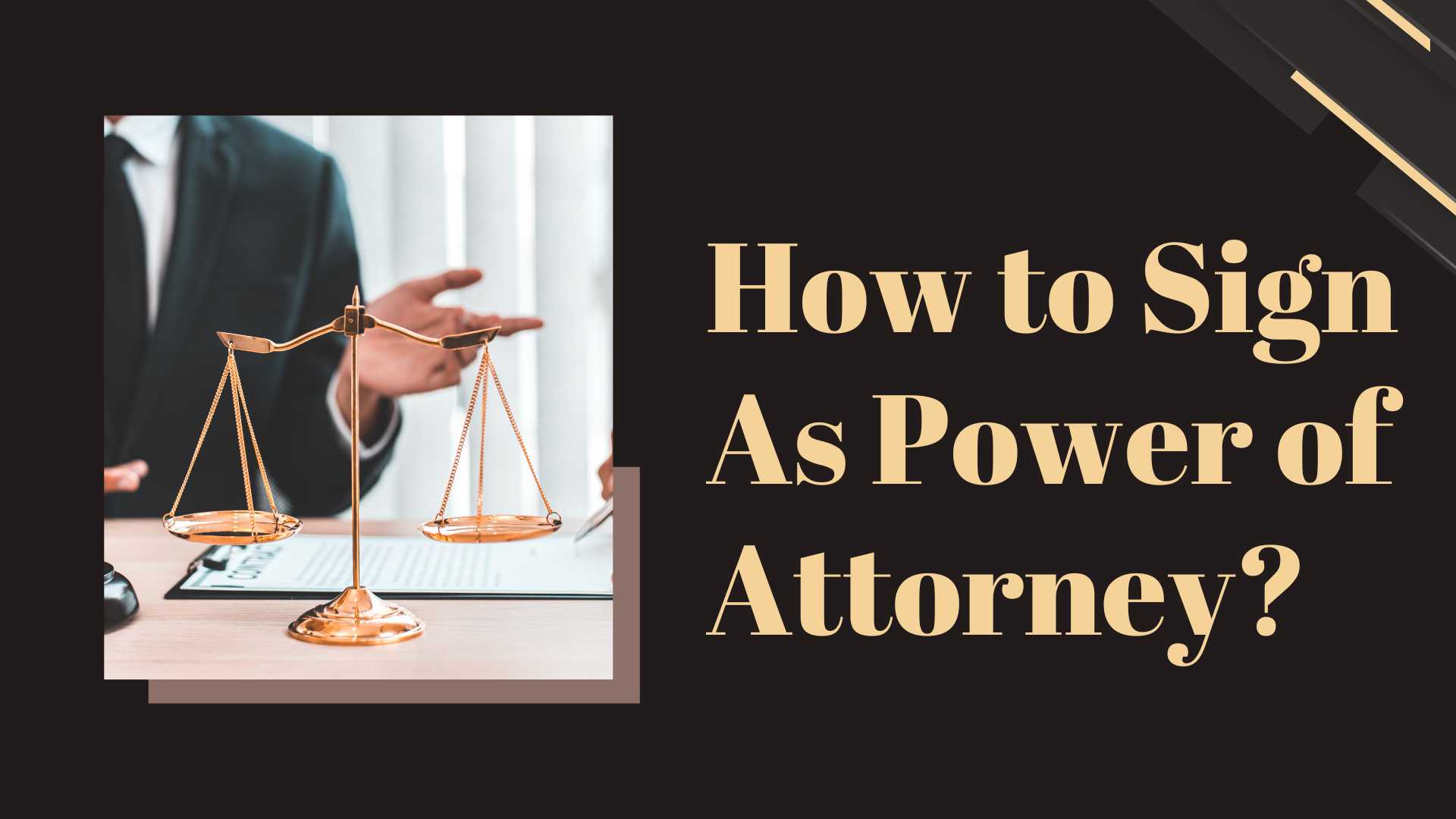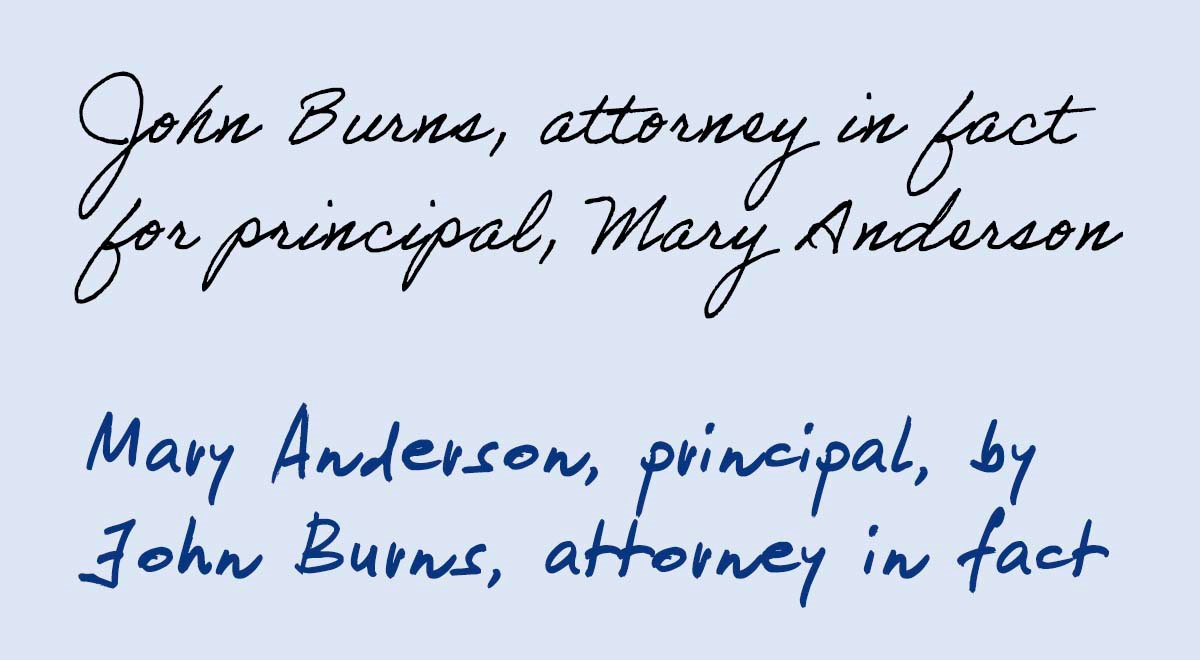How to Sign As Power of Attorney

To sign as a Power of Attorney (POA), write your name followed by “as POA” after the grantor’s name. Ensure the document reflects your authority to act on their behalf.
Signing as a Power of Attorney is a significant responsibility, allowing you to manage another person’s financial, property, or medical decisions. It’s essential that the signature process is done correctly to maintain legal validity. The principal, the person granting the authority, must have willingly signed the Power of Attorney document, which typically needs to be notarized or witnessed, depending on state laws.
How to Sign As Power of Attorney? Each time you sign as a POA, clarity is key; your signature should communicate your role and authority without ambiguity. Knowing the correct signing procedure and adhering to the legal requirements prevents any future disputes or legal complications. Always check with local regulations to ensure compliance, as legal provisions can vary widely.
Introduction To Power Of Attorney Signatures
Understanding how to sign as Power of Attorney (POA) is crucial. It ensures that a delegated person can legally act on another’s behalf. This guide illuminates the process, highlighting its importance and the correct protocol for signing under a POA.
What Is Power Of Attorney?
A Power of Attorney is a legal document. It allows one person to make decisions for another. The person who creates the POA is the principal. The person given authority is the agent.
- General POA – Covers broad tasks.
- Special POA – Limits power to specific areas.
- Healthcare POA – Focuses on medical decisions.
- Durable POA – Remains active if the principal becomes incapacitated.
Significance Of Signing As A Power Of Attorney
Signing as a POA carries weight. It is a responsibility not to be taken lightly. Documents signed by a POA are as legally binding as if the principal had done so themselves. A correct signature involves:
- Writing the principal’s name, which shows who you are acting for.
- Signing your own name next, indicating that you are the agent acting under Power of Attorney.
- Noting ‘as Power of Attorney’ after your signature, to clarify your legal role.
Determining The Scope Of Authority
Signing as a Power of Attorney (POA) is a significant responsibility. When you take on this role, you carry out decisions on someone else’s behalf. It’s crucial to understand the kind of power you have. The scope of authority can vary, and it hinges on the specific type of POA arrangement in place. Let’s examine the various types and how they define what you can and cannot do.
Types Of Power Of Attorney Arrangements
Understanding different POA types is the first step before signing. Here are the main categories:
- General Power of Attorney – This type allows you to make a wide range of decisions.
- Limited Power of Attorney – Your actions here are restricted to specific areas.
- Health Care Power of Attorney – It gives you the authority to make medical choices.
- Durable Power of Attorney – This remains active even if the principal becomes incapacitated.
Understanding The Limits Of Your Authority
Even with a power of attorney, your scope of action has limits. You need to know these boundaries to act correctly. For instance, a Limited POA lets you sign checks but not sell property. Below are the key points to remember:
- Read the document carefully. All your powers are listed there.
- Power of Attorney does not allow you to act against the principal’s wishes.
- You may still need a principal’s consent for some decisions, depending on the POA type.
A clear understanding of your authority ensures that you can make decisions within legal and ethical boundaries. It helps avoid disputes and maintains trust.
Preparation Before Signing
Stepping into the shoes of a Power of Attorney requires readiness. When signing documents on behalf of someone else, followers must understand the legal and personal responsibilities that form part of the Power of Attorney (POA) role. Preparation is the key to ensuring all actions taken are valid and reflect the principal’s wishes. Proper preparation includes verifying the POA document and knowing what the principal expects from the agent. Here is how to prepare:
Verifying The Power Of Attorney Document
Confirmation of a valid Power of Attorney is the first crucial step. Examine the POA document with care. Check the following:
- Legibility: Ensure all parts of the document are readable.
- Signatures: Confirm the principal’s signature and date.
- Notarization: Verify if a notary public has stamped the document.
- Authority Granted: Understand the scope and limits of powers given.
Knowing The Principal’s Expectations
Determine the principal’s needs and instructions. This includes:
| Expectation | Action Required |
|---|---|
| Specific Instructions | List tasks and decisions the principal expects. |
| Decision-Making Preferences | Understand how the principal makes choices. |
| Communication Style | Engage in a way the principal prefers. |
Discuss expectations in detail with the principal. Document these conversations. This ensures clarity and compliance with the principal’s wishes.

Credit: www.nationalnotary.org
The Correct Way To Sign As A Power Of Attorney
Acting as a Power of Attorney (POA) positions you to make decisions on behalf of someone else. It’s crucial to understand the correct signing method to maintain legal validation. Missteps could cause documents to be invalid. Learn the standard procedures and state-specific rules for signing as a POA.
Standard Signing Procedures
Signing as a POA follows a general format to ensure clarity and correctness. These steps are widely accepted:
- Start with the principal’s name: John Doe.
- Use “by” to show that someone else is signing: by [Your Name].
- Indicate your role: as Power of Attorney.
Together, it forms “John Doe by Jane Smith as Power of Attorney.” Signatures should be followed by the printed POA’s name and the date.
State Laws And Variations
Different states have different rules. In New York, for example, signing must strictly adhere to the prescribed format.
| State | Signing Format |
|---|---|
| California | Principal’s Name, by POA’s Name, as Agent |
| Florida | POA’s Name, as Agent for Principal’s Name |
Consult local laws to ensure compliance. You may need to include the POA document reference number or date.
Common Mistakes To Avoid
Signing documents as a Power of Attorney (POA) carries great responsibility. Certain mistakes during this process can lead to legal issues or document rejection. It’s crucial to avoid common pitfalls.
Not Indicating Representation
When signing as a POA, always indicate that you are acting on someone else’s behalf. Sign the principal’s name followed by your own, with a designation showing your role. For example, “Jane Doe by John Smith as POA”. Remember to:
- Use the correct format: Always check if there is a preferred format
- Be clear: Your role should stand out to prevent confusion
- Double-check: Review the signature before finalizing the document
Signing Without Authority
Signing a document without confirmed authority can have serious consequences. Ensure the POA document is valid and active. Confirm your powers haven’t been revoked. Avoid signing if:
- The document is outdated: Verify the POA’s validity
- Your authority is questionable: Only sign for matters within your power
- There’s uncertainty: Consult a lawyer if unsure about your authority
Consequences Of Misusing Power Of Attorney
Consequences of Misusing Power of Attorney can be severe, impacting the legal and financial realms for both the appointed person and the individual they represent. Acting as a Power of Attorney (POA) carries with it a serious obligation to act responsibly. Missteps or ethical violations may result in criminal charges, civil liability, or both. Understanding the potential fallout helps individuals avoid pitfalls associated with managing someone else’s assets.
Legal Implications Of Improper Signing
Signing documents under a Power of Attorney requires precision, honesty, and adherence to legal standards. When misused, the consequences include:
- Fines or restitution payments.
- Criminal prosecution for fraud or theft.
- Loss of rights to act as an agent.
Proper signing is a must. It involves appending the principal’s name, followed by the POA’s name, and the indication of acting as a Power of Attorney.
Protecting Yourself From Liability
To shield oneself from unnecessary legal exposure, agents should:
- Understand the POA document thoroughly.
- Document all actions and decisions made.
- Keep personal funds separate from those of the principal.
- Consult a lawyer for complex decisions.
Failing to do so may result in significant legal consequences and damage to personal reputation.

Credit: www.wikihow.com
Conclusion
Signing as a power of attorney is a significant responsibility that should be approached with care. Remember to clearly mark your status next to your signature. This helps avoid legal misunderstandings and ensures the principal’s intentions are honored. For further guidance, seek legal advice.
Taking these steps will safeguard your actions and honor the trust bestowed upon you.
Amelia Justiceberg, a distinguished legal luminary, thrives on the intersection of empathy and legal acumen. As a prominent family law attorney, she orchestrates compassionate resolutions amidst complex dynamics. Justiceberg's courtroom finesse and dedication to fairness define her practice. Beyond litigation, she ardently advocates for social justice, solidifying her reputation as an influential force in the legal landscape.






